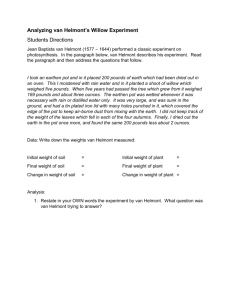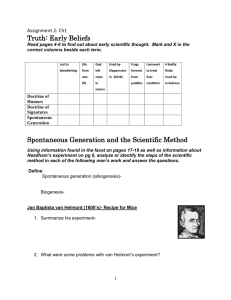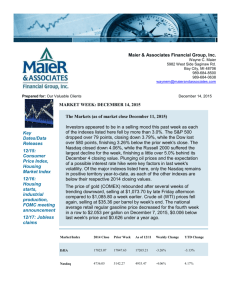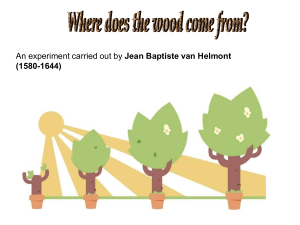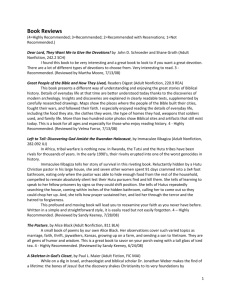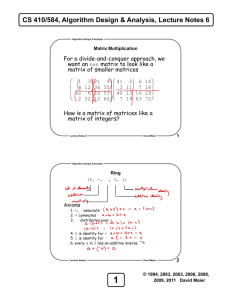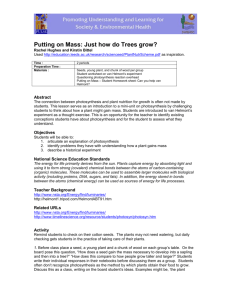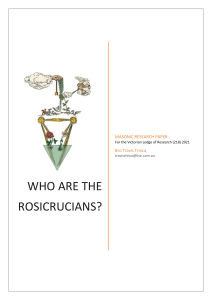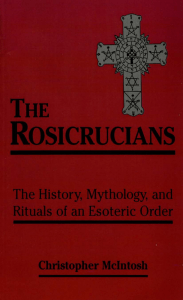Chapter 1c ORIGINS OF THE ROSICRUCIAN ORDER
advertisement
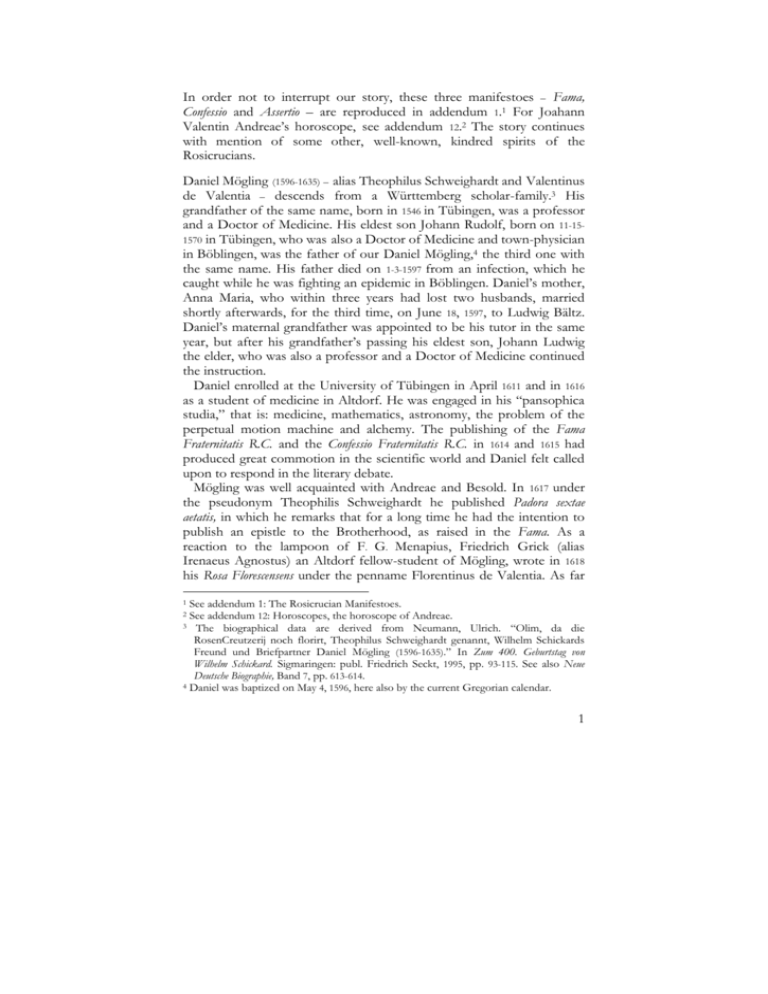
In order not to interrupt our story, these three manifestoes – Fama, Confessio and Assertio – are reproduced in addendum 1.1 For Joahann Valentin Andreae’s horoscope, see addendum 12.2 The story continues with mention of some other, well-known, kindred spirits of the Rosicrucians. Daniel Mögling (1596-1635) – alias Theophilus Schweighardt and Valentinus de Valentia – descends from a Württemberg scholar-family.3 His grandfather of the same name, born in 1546 in Tübingen, was a professor and a Doctor of Medicine. His eldest son Johann Rudolf, born on 11-151570 in Tübingen, who was also a Doctor of Medicine and town-physician in Böblingen, was the father of our Daniel Mögling,4 the third one with the same name. His father died on 1-3-1597 from an infection, which he caught while he was fighting an epidemic in Böblingen. Daniel’s mother, Anna Maria, who within three years had lost two husbands, married shortly afterwards, for the third time, on June 18, 1597, to Ludwig Bältz. Daniel’s maternal grandfather was appointed to be his tutor in the same year, but after his grandfather’s passing his eldest son, Johann Ludwig the elder, who was also a professor and a Doctor of Medicine continued the instruction. Daniel enrolled at the University of Tübingen in April 1611 and in 1616 as a student of medicine in Altdorf. He was engaged in his “pansophica studia,” that is: medicine, mathematics, astronomy, the problem of the perpetual motion machine and alchemy. The publishing of the Fama Fraternitatis R.C. and the Confessio Fraternitatis R.C. in 1614 and 1615 had produced great commotion in the scientific world and Daniel felt called upon to respond in the literary debate. Mögling was well acquainted with Andreae and Besold. In 1617 under the pseudonym Theophilis Schweighardt he published Padora sextae aetatis, in which he remarks that for a long time he had the intention to publish an epistle to the Brotherhood, as raised in the Fama. As a reaction to the lampoon of F. G. Menapius, Friedrich Grick (alias Irenaeus Agnostus) an Altdorf fellow-student of Mögling, wrote in 1618 his Rosa Florescensens under the penname Florentinus de Valentia. As far See addendum 1: The Rosicrucian Manifestoes. See addendum 12: Horoscopes, the horoscope of Andreae. 3 The biographical data are derived from Neumann, Ulrich. “Olim, da die RosenCreutzerij noch florirt, Theophilus Schweighardt genannt, Wilhelm Schickards Freund und Briefpartner Daniel Mögling (1596-1635).” In Zum 400. Geburtstag von Wilhelm Schickard. Sigmaringen: publ. Friedrich Seckt, 1995, pp. 93-115. See also Neue Deutsche Biographie, Band 7, pp. 613-614. 4 Daniel was baptized on May 4, 1596, here also by the current Gregorian calendar. 1 2 1 as is known Grick descended from Wesel in the former county Kleve, and he, among others, earned a living as a tutor for the Nuremberg patrician sons Hieronymus and Christian Scheurl.5 In Rosa Florescensens, Mögling is the first one to use the word “pansophy,” earlier than Comenius: “And that is the Ergon Fratrum, the preliminary work Regnum Dei and the highest science, by them [the Rosicrucians] named pansophy.”6 In addition to his Pandora, at the beginning of March 1617 and “within half a day,” Mögling wrote for Caspar Tradel, Doctor of Laws, his Speculum Rhodostauroticum,7 under his penname Theophilus Schweighardt. Three engravings had been depicted in this work, of which the second demonstrates the Temple of the Rose Cross. For the meaning of the symbolism in this illustration the reader is referred to addendum 10.8 Grick continued attacking Mögling, despite Mögling giving no reaction to his lampoons. Grick, therefore, thought cunningly on Easter 1619, to write himself the answer under the penname F. G. Menapius.9 On January 1, 1619, Mögling registered again at the university, and completed his doctoral degree of medicine. He was appointed Court Physician in Butzbach, Germany, on June 2, with the remark that he would be useful also as a mathematician, particularly in astronomical observations. A year later, on May 30, 1622, he married Susanna Peszler in Nuremberg, with whom he fathered at least three children. He died on August 29, 1635 in Butzbach as a victim of pestilence, only two months before his best friend, Wilhelm Schickard (1592-1635) mathematician and orientalist in Tübingen. The English statesman Francis Bacon, who was appointed Baron of Verulam and Viscount of St. Albans at the end of his career, appeared to have studied well the Fama and Confessio. The impression that these works made upon him is evidenced in his New Atlantis, written between 1622 and 1624. The first sentence: “We sailed from Peru” can also be found in the Confessio.10 The first of the six rules in the Fama, the free healing of the sick, appears again in the house of the stranger in New Atlantis. The information that envoys were sent to Bensalem, to wander around the world to inform themselves about the state of science, runs parallel Neumann, Daniel Mögling, pp. 103, 104. R. van Dülmen, Utopie, p. 227, note 21. 7 Neumann, Daniel Mögling, p. 104. 8 Addendum 10, Symbolism, see: a. The Collegium Fraternitatis. 9 [Pseudo] Theophilis Schweighartdt [Friedrich Grick] Menapius, Rosae Crucis, Das ist Bedencken [...]. n. p. [Nurnberg]: 1619. See Neumann, Olim, da die RosenCreutzerij noch florirt, Theophilis Schweighartdt genannt, p. 107. 10 Confessio. Kassel: 1615, p. 80. 5 6 2 to the Fama, where the Brothers, after being sufficiently informed, separate and disperse over several countries to come in contact with the scholars. Bacon’s description of the learned of Solomon’s House, is the elaboration of a short sketch about the study of the Brotherhood R. C. in the Fama. Where the Brotherhood is situated is not revealed. In the Confessio, in chapter V it says only: “He has enveloped us so protectively with his cloud, that his servants cannot be done violence. For that reason we can no more be seen by human eyes, unless they have borrowed those of an eagle.” At the end of the Fama is written: “Also our building, even if a hundred thousand people have seen it from nearby, remains untouched, un-devastated, invisible and quite hidden from the irreligious in eternity.” At the end of his work, Bacon also let the Tirsan of Solomon’s House say, “because we are here in God’s bosom, an unknown country.”11 20. Francis Bacon, 1561-1626. 21. Michael Maier, 1568-1622. Michael Maier (1568-1622), was born in the summer of 1568 to a Lutheran family in Kiel in the state of Schleswich-Holstein, then Danish, now German, territory.12 His father, Peter, was a well-to-do gold embroiderer Bacon, Francis. Het Nieuwe Atlantis..Translated, introduced and provided with annotations by A.S.C.A. Muijen, Baarn: Ambo 1988. See Santing, De historische Rozenkruisers, p. 76 and Yates, The Rosicrucian Enlightenment, London, Boston 1972, pp. 125-129. 12 Figala, Karin and Neumann, Ulrich. “Ein Früher Brief Michael Maiers (1568-1622) and Heinrich Rantzau (1526-1598), Einführung, lateinischer Originaltext und deutsche 11 3 in the service of the knighted and royal Danish governor, Heinrich von Rantzau (1526-1598). As a bright young boy, Michael started school at age 5. His father died in about 1584 when Michael was 16 years of age, but financial help made it possible for him to continue his study. After two years in a high school in the neighborhood of Kiel, he enrolled at the University of Rostock in February 1587. He studied mainly physics, mathematics, astronomy, Greek and Latin. Michael returned home to his mother Anna and his sister in 1591, unqualified, probably from lack of money. For a year he occupied himself with alchemy. Probably with financial aid and by the suggestions of his friend Matthias Canaris and his family, he decided to study at the University of Frankfort on the Oder in the summer of 1592. By October 12, the 24-year-old student had gained his Master Degree in physics.13 He remained for a year in Frankfort and upon returning home resumed his systematic study of alchemy. Later he embarked on an odyssey through Danzig, Riga and Dorpat and some islands in the Baltic Sea, finally arriving in Russia. Immediately after returning to Kiel he set out for Padua, Italy, where he enrolled as a medical student on December 4, 1595. There he was crowned poeta laureatus caesareus [Imperial Poet Laureate] and visited Bologna, Florence, Siena, and Rome. In Padua an unpleasant incident occurred in July 1596. Maier was involved in a conflict with a fellow student from Hamburg and had injured him severely. His case went to trial before the elders of the “German Nation” at Padua, the administrative body for German scholars, which found him guilty and ordered him to pay expenses and offer an apology - however, the very next day he fled in secret from Padua to Basel, Switzerland. There he continued his study and on Übersetzung.” In Festschrift für Helmut Gericke (Reihe “Boethis” Band 12) Stuttgart: 1985, pp. 327-357. See further, Neue Deutsche Biographie, volume 15, pp. 703-704 and Figala, Karin and Neumann, Ulrich, “Author, cui nomen Hermes Malavici. New Light on the Bibliography of Michael Maier (1569-1622).” In Piyo Rattansi and Antonio Clericuzio, eds. Alchemy and Chemistry in the 16th and 17th Centuries. Dordrecht-Boston: 1994, pp. 121147. Craven, J.B. Count Michael Maier, Doctor of Philosophy and of Medicine, Alchemist, Rosicrucian, Mystic, 1568-1622. Life and Writings. Kirkwall: 1910, reprinted 1968, London: Dawson of Pall Mall, pp. 65-67. See also, Leibenguth, Erik. Hermetische Poesie des Frühbarock. Die “Cantilenae intellectualis” Michael Maiers. Edition mit Übersetzung, Kommentar und Bio-Biblographie. Tübigen: Max Niemeyer Verlag, 2002. And Tilton, Hereward. The Quest for the Phoenix, Spiritual Alchemy and Rosicrucianism in the Work of Count Michael Maier (1569-1622). Berlin – New York: Walter de Gruyter, 2003. 13 Maier was a Lutheran who lived in both Protestant and Roman Catholic communities. It is not certain what kind of Calendar was used; therefore, the original, official dates have not been changed. 4 November 4, 1596, obtained an M.D. degree with a thesis on epilepsy whereupon he returned home. For a second time Maier undertook a voyage on the Baltic Sea. It was in Danzig that he came in contact with alchemists and found accommodation with a host who was interested in chemistry. He became a wealthy man when an incurable hypochondriac asthmatic gave him permanent employment, but due to the epidemic around Danzig, they fled to his country estate, a neighborhood where they did alchemical experiments and where Maier studied his employer’s alchemical library for a period of two years. The reason he returned home was probably because his host had received a yellowish powder prepared some years prior by an Englishman, with which the symptoms vanished immediately. It definitely was linked to this sample of the so called “aureum potabile” (drinkable gold) produced by the London physicianalchemist Francis Anthony (1550-1623). At some point in 1609, Maier came in contact with Emperor Rudolf II (1552-1612) in Prague at a center of alchemy. He became Court Physician on September 19, 1609, and was ennobled on September 29 to Count Palatine, but lack of money and no salary forced Maier to leave. He traveled via Leipzig to Kassel where he went to the court of Landgrave Moritz von Hessen-Kassel and offered his service in vain. At the end of 1611 Maier undertook a journey to England where he stayed for four years. There he occupied himself with alchemy as before, but in close cooperation with the physician-alchemist Francis Anthony (1550-1623). It was in 1613 that Maier heard for the first time of the existence of a secret Brotherhood, a certain “fraternitas R. C.,” in which he saw the embodiment of his own natural historic ideals and expectations. That Maier met the English proclaimer of the Rosicrucian Order, Robert Fludd, as some writers suggest but do not prove, is very unlikely. Maier returned to the Continent in 1616 and traveled via Cologne to Frankfurt am Main where he arrived in about August of that year. He dedicated the book Jocus severus (1617), written in England on the road from England to Bohemia “to the true known and unknown lovers of alchemy in Germany and especially that German Order that up to now however has been secret, that one, on the basis of its Fama Fraternitatis and its Confessio, has to admire and hold in great esteem.” He became ill in Frankfurt am Main with quartan fever (malaria), probably incurred in Italy, and due to this delay was able to visit the biannual book fair where he learned more about the Rosicrucians. He lived there in the vicinity of the publishers, Johann Theodor de Bry and Lucas Jennis, who published the majority of his works until his death. In 5 the past he occupied himself with alchemy; now he became a defender of the Rosicrucian Order. In the summer of 1617 Maier married, and in April of 1618 he said his wife was ready to deliver at any moment. There is no mention of the name of his wife or the event of the birth. Shortly after April 1618 Maier found employment with Landgrave Moritz von Hessen-Kassel, also named Moritz-the-learned (1572-1632) as “Medicus und Chymicus von Haus aus” (physician and alchemist by birth). Maier died in the summer of 1622 in Magdeburg from malaria. In Michael Maier’s Silentium post clamores [Silence After the Clamor] of 1617, he explains why the Order treats its applicants with silence; that the Order is a mystery school like those of ancient times such as Eleusis and Orphis; that the Fama and the Confessio contain nothing contrary to reason, nature, experience, or the possibilities of things; that the Brothers hold the rose as a remote prize, but they impose the cross on those who enter; and that just like the Pythagoreans and Egyptians, the Rosicrucians exact vows of silence and secrecy. Ignorant men have treated the whole as a fiction; but this has arisen from the five years’ probation to which they subject even well qualified novices before they are admitted to the higher mysteries.14 His Themis Aurea of 1616 deals with the six golden laws or rules of the Brotherhood that are mentioned in the Fama.15 In this book, Maier mentions that the compound medicine that the Rosicrucians administer to the sick is, as it were, the marrow of the great world (macrocosm). It is the fire of Prometheus, which he stole from the sun, but a fourfold fire is required to bring this medicine to perfection. The Brothers, however, are of the opinion that there is a natural virtue and certain predestination flowing from the influence of heavenly bodies. Robert Fludd (1574-1637) – born at Milgate House in the parish Bearsted and county of Kent in England – graduated in the Arts and from age 24 to age 30 studied medicine and traveled through France, Spain, Italy, and Germany.16 Fludd wrote many books beautifully illustrated with Craven, J. B. Count Michael Maier, Doctor of Philosophy and of Medecine, Alchemist, Rosicrucian, Mystic, 1568-1622. Life and Writings. Kirkwall: 1910, reprinted London: Dawson of Pall Mall, 1968. pp. 65-66. 15 Maier, Michael. Laws of the Fraternity of the Rosie Crosse (Themis Aureae) Facsimile reprint of the original English edition of 1656, Los Angeles: The Philosophical Research Society. Craven, J. B. M. Maier, pp. 98-104. 16 Huffman, William H. Robert Fludd and the end of the Renaissance. London and New York: Routledge, 1988, pp. 4-14. See also: Craven, J. B. Doctor Robert Fludd (Robert de Fluctibus), The English Rosicrucian, Life and Writings. Kirkwall: 1902, reprint, n. p., n. d. 14 6 alchemical engravings. He published his Apologia Compendiaria. Fraternitatum de Rosea Cruce suspicions et infamiæ maculis aspersam, veritas quasi Fluctibus abluens et abstergens, in 1616 in Leiden, the Netherlands, a short defense of the Brotherhood that appeared in elaborated form, also in Leiden under the title, Tractatus apologeticus integritatem Societatis de Rosea Cruce defendens. Fludd lived a chaste life, because he saw sexual desire as the fall of man. By his 22nd year Fludd was very skilled in natal and horary astrology. We read in his Utrisque Cosmi Historia, Tractatus Secundus 17 the following: 22. Robert Fludd, 1574-1637. 23. “Dat Rosa Mel Apibus” from Summum Bonum, J. Frizius, 1629. “While I was working on my music treatise, I scarcely left my room for a week on end. One Tuesday a young man from Magdalen came to see me and dined in my room. The following Sunday I was invited to dine with a friend from the town, and while dressing for the occasion I could not find my valuable sword-belt and scabbard, worth ten French gold pieces. I asked everyone in college if they knew anything about it, but with no success. I therefore drew a horary chart for the moment at which I had noticed the loss, and 17 Roberto Fludd, alias de Fluctibus. Utrisque Cosmi Historia, Tractatus secundus, DE NATURÆ SIMILIA SEU Technica macrocosmi historia. Oppenheim: 1618, treatise 2, ch. 6, part 1. The English text can be found in: Jocelyn Godwin, Robert Fludd, Boulder: Shambala, 1979, p. 6. The French rendering of the 2nd treatise is from Pierre Piobb; Robert Fludd, Étude de Macrocosme, Traité d’Astrologie Générale (De Astrologia). Paris: H. Daragon, Libraire – Éditeur, 1907, where the text can be found in book 6, pp. 258-260. 7 deduced from the position of Mercury and other features that the thief was a talkative youth situated in the East, the stolen goods must now be in the South. “On thinking this over I remembered my guest of Tuesday, whose college lay directly to the east of St. John’s. I sent my servant to approach him politely, but he swore that he had touched nothing of mine. Next I sent my servant to speak to the boy who had accompanied my visitor on that day, and with harsh words and threats he made him confess that he had stolen the goods and taken them to a place I knew near Christ Church where people listened to music and consorted with women. This confirmed my conjecture that the place was to the south of St. John’s, and since Mercury had been in the house of Venus, it fit with the association with music and women. After this the boy was taken into the presence of his companion and flung to the ground. He swore that he had indeed committed the crime, and begged my servant to say no more: he promised to retrieve the belt and scabbard on the following day. This was done, and I received my stolen property wrapped in two beautiful parchments. It emerged that the musichouse near Christ Church was the lair of a receiver of stolen goods who had robbed many degenerate scholars, wasting them with gluttony and womanizing. My friend implored me to desist from the study of astrology, saying that I could not have solved this crime without demonic aid. I thanked him for his advice.” Jacob Boehme (also Böhme) (1575-1624) was born in Alt-Seidenberg near Görlitz, Germany a child of poor and humble farmers. His birth date cannot be obtained, nor is there any portrait made during his lifetime, except for a description by his friend and pupil, Abraham von Frankenberg: “His physical condition was weak and he looked ill; he was small of stature, with a low forehead, sunken temples, a somewhat hooked nose, grey - almost sky-blue bright eyes and a short thin beard. With a timid voice and dulcet tongue, he was understated in gesture, unassuming, modest with words, meek in his conduct, patiently enduring and kind-hearted.”18 He married at age 24, and obtained civil rights at Görlitz, where he established himself as a shoemaker. Between 1600 and 1606 the couple produced five sons. In 1612 he wrote his Aurora and circulated copies. Boehme earned the name “Philosophus Teutonicus” 18 8 von Frankenberg, Abraham. “Ausführlicher Bericht,” in J. Böhme, Sämtliche Schriften, Band 10, Stuttgart. Will-Erich Peuckert, 1961, pp. 20-21, § 27. and was also known as a seer. From that time pastor Gregor Richter made life very difficult for him. In 1613, at 38 years of age, he sold his shoemaker’s workshop and started a yarn business with his wife. In the same year a writing ban was imposed on him, but in 1619 he again started writing. Even on his deathbed he was obliged to answer questions about his faith to the minister who subsequently refused to bury him, and did so only after the city administration forced him. Joachim Morsius (1593-1644), who idolized the Rosicrucians, had become acquainted with the alchemist Balthasar Walter who told him about the remarkable master shoemaker of Görlitz who understood all of the arts [knowledge] of the Rosicrucians.19 24. Jacob Boehme, 1575-1624. 25. Plate 2 of Gichtel’s Theosophia Practica, 1723. Johann Georg Gichtel (1638-1710),20 born in Regensburg, Germany, was a great admirer and follower of Boehme. He had read law and theology 19 20 Peuckert, Will Erich. Die Rosenkreuzer. Jena: Eugen Diederichs, 1928, p. 288. For an elaborated, well documented life history see: Lemper, Ernst-Heinz. Jacob Böhme, Leben und Werk. Berlin, GDR: Union Verlag, 1976. Also Wehr, Gerard. Jacb Böhme, Rohwolt, Reinbeck near Hamburg: Rowohlt, 1971. Gichtel, Johann Georg. Theosophia Practica. (1st edition 1696, reprint 1979), with an introduction by Agnes Klein, Schwarzenburg, Switserland: Ansata, 1979, introduction pp. 7-8. See also: Gorceix, Bernard. Johann Georg Gichtel, Theosophe d’Amsterdam. Bordeaux: 1974. 9 and practiced as a lawyer. Later, after experiencing the spiritual world, he founded an esoteric movement. The church banned him in about 1670 and his property was seized, after which he took refuge in the Netherlands, where he spent the remaining 40 years of his life. Among other things, he gained recognition for being the first to edit the collected writings of Boehme in 1682 in Amsterdam. Gichtel’s letters to his friends were printed in 5 volumes. Of special interest is his little book, Theosophia Practica, which was compiled in 1696 by his friend Johann Georg Graber, who also provided the added illustrations with comments. It was enlarged in 1722. The little book contains five colored plates, of which number 2 describes the centers in the desire body. Gichtel had kept these drawings secret from 1695 to his death and finally, in 1723, 10 years after he died, they were published. The theosophist C.W. Leadbeater (1854-1934) knew of these plates and depicted one illustration, taken from a French edition, in his book The Chakras.21 26. J. B. van Helmont, 1579?-1644, and his son François Mercurius. 27. J.A. Comenius, 1592-1670. The South Netherlands physician Joannes Baptista van Helmont (1579?1644), was baptized on January 22, 1579 (NS), as the youngest of seven children from a noble, Roman Catholic family in Brussels.22 He was 15 21 Leadbeater, C. W. The Chakras. Madras, India: The Theosophical Publishing House, 1966, opposite page 14. 22 His baptismal date is certain, however his birth date is uncertain. See, Le Folklore Brabançon. Volume 13, no. 75-76. December 1933 and February 1934. Bulletin de service de recherches historiques en folcloriques du Brabant. Double issue entirely devoted to 10 years of age when he finished his Philosophy studies in Leuven and 20 when he obtained his Doctor of Medicine degree. Van Helmont married the aristocrat, Marguerite van Ranst, in 1609. They went to live in Vilvoorde where they had three children. The middle child was a son named Franciscus Mercurius, who published the books of his father posthumously on December 30, 1644. Van Helmont was the first to discover the functions of the stomach in relation to the other organs. In the history of chemistry, van Helmont is known as the discoverer of the gases. In his Ortus Medicinæ, published in 1648 by his son in Amsterdam, he writes, “This vapor, which I have called Gas, is not far removed from the Chaos the ancients spoke of.” and further on in the same work, “This, hitherto unknown Spirit I call Gas.”23 In The Rosicrucian Cosmo-Conception, chapter 11, Max Heindel explains that under Chaos we must understand the Spirit of God, which penetrates every part of infinity. As an old maxim describes it: “Chaos is the seedground of the Cosmos.” Van Helmont had a hard time because he supported Rudolf Goclenius Minor (1572-1621), who was accused of idolatry and magic. Goclenius was appointed by von Hessen-Kassel as a professor in chemistry, mathematics and medicine in Marburg. He was an adherent of the teachings of Paracelsus and he engaged himself with the Cabbala. Van Helmont had written a booklet in defense of his friend, Goclenius that was published without his knowledge. An investigation followed, and in 1623 the members of the medical faculty of Leuven designated this work as a monstrous pamphlet. The Spanish inquisition in its pronouncements of suspicions of witchcraft, made 27 statements against it. The Mechelen Roman-Catholic Ecclesiastical Court decided to prosecute in 1627 and demanded that van Helmont should retract his remarks in public, to which he consented. During an interrogation in March 1634, with regard to a confiscated manuscript of his, van Helmont was questioned if he, in using the name “Brothers,” had meant the Brothers of the Rose Cross. He answered that he did not know them, and to take it for a dream. He declared himself a Roman-Catholic. Van Helmont apparently had 23 J. B. van Helmont. Veille Halle au Blé. And Nève de Mévergnies, Paul. Jean Baptiste van Helmont, philosophe par le feu. Faculté de Philosophie et Lettres de L’Université de Liège. Paris, Librarie E. Droz, 1935. van Helmont, J. B. Ortus Medicinæ, etc.. Amsterdam: Lowijs III, Elzevier, 1648, tract 14 “Progymnasma meteori,” p. 73, § 29; and tract 20 “Complexionum atque Mistionum Sigmentum” p. 106, § 14. 11 become so fearful that he would not admit to knowing those whom he had previously defended.24 Jan Amos Komenský (1592-1670), better known under his latinized form, “Comenius,” was born on March 28 (NS) at Nivnický (Nivnice) in East Moravia, in the Czech Republic.25 He was a member and later a bishop of the Community of the Moravian Brethren, a schism of the Hussites and is known as one of the greatest educators of his time. Because of the Roman-Catholic Hapsburgian power over the Czech Republic, he had to flee. Of his many books, one of special interest, The Labyrinth of the World and the Paradise of the Heart,26 [Komensky, John Amos. London: 1950] written in 1623 and published for the first time in 1631 in Poland, relates the adventures of a pilgrim who visits all kinds of people and gives an account of it. He arrives at chapter 16 with: “The pilgrim considers the Rosicrucians.” In the margin is written: “Fama Fraternitatis anno 1612, latine ac germanice edita,” edited in Latin [incorrect] and German, so he had in his possession a Fama manuscript that was published in 1614. Comenius died on November 25, 1670 (NS) in Amsterdam. 28. J. W. von Goethe, 1749-1832. 29. The Count of Saint Germain, ??-1784. Snoek. Rozenkruisers, pp. 96-100. Other consulted literature: Stroobant, M. Louis, Nauwelars, M., Behaeghel, M.. “J. B. van Helmont.” In Le Folklore Brabançon. December 1933 and February 1934. Pagel, Walter. Jo. Bapt. van Helmont, Einführung in die philosophische Medizin, des Barocks. Berlin: 1930. Nève de Mévergnies, Paul. Jean-Baptiste van Helmont ; Philosophe par le feu. Paris and Luik, Belgium: E. Droz, 1935. 25 For the dates see: Blekastad, Milada. Comenius, (Jan Amos Komenský). Oslo, Norway: Universitetsforlaget, 1969, p. 16. 26 Consulted literature: Blekastad, Comenius. 24 12 On pages 145 and 249 of The Rosicrucian Cosmo-Conception, Max Heindel refers to Johann Wolfgang von Goethe (1749-1832) as an initiate. His connection with the Rosicrucian Order is particularly expressed in his poem The Secrets, a fragment, which was written in 1784/85 and published in 1816. The long poem officially contains 44 verses, each with eight lines, but it actually has two, probably three, more strophes to be counted.27 The poem tells the story of a candidate for initiation, named Marcus. Goethe himself summarized the poem in 1816 as follows: “A young regular clergy, getting lost in a mountainous area, found at last in a charming valley, a beautiful building that leads to suspect to be the residence of devout, mysterious men. He finds there twelve knights, who after having endured a stormy life, in which trouble, suffering and danger succeeded each other, have taken upon themselves the duty at last, to live here and to serve God secretly. A thirteenth one, which they consider to be their leader, being on the point of departure: in which way remains hidden. But during the past days he had started to tell his life story, of which the newly arrived regular clergy confers to him a short allusion with a good and warm reception. A mysterious, nightly appearance of festal youngsters, who hurrying along lightens the garden with torches, form to a close.”28 The ninth stanza of this poem, where Brother Marcus, in front of the door, gazes upon the Rosicrucian emblem above and says: Er fühlet neu, was dort für Heil entsprungen, Den Glauben fühlt er einer halben Welt; Doch von ganz neuem Sinn wird er durchdrungen, Wie sich das Bild ihm hier vor Augen stellt: Es steht das Kreuz mit Rosen dicht umschlungen. Wer hat dem Kreuze Rosen zugestellt? Es schwillt der Kranz, um recht von allen Seiten Das schroffe Holz mit Weichheit zu begleiten. He feels anew what there for goodness sprang forth, The faith he felt beheld in half a world; But with full new sense now permeated, As the image before his eyes imposed: See the Weimar edition, 1890, volume 16, pp. 436-437. Goete’s, Sämmtliche Werke in fourty volumes. Second volume. Stuttgart and Augsburg: F. G. Cotta, 1855, pp. 360-363. 81 A verbal translation from the German text. 27 28 13 There stands the cross with roses closely composed. Who to the cross added roses? It does swell the wreath, for the good from all views The coarse wood with softness imbued.81 Heindel calls the Count of Saint-Germain - who in the 18th century maintained diplomatic relations from the French court with the goal to prevent the French Revolution (1789-1794) – an embodiment of Christian Rosencreutz.29 The first evidence of his appearance in The Hague is a letter which he sent from there on November 22 to the British physicist Hans Sloane (1660-1753). It rests in the British Museum, but a facsimile is contained in the book by Cooper Oakley.30 Of him is said, “M. de St. Germain ate no meat, drank no wine, and lived according to a strict regimen.”31 And further, “He looked about fifty, is neither stout nor thin, has a fine intellectual countenance, dresses very simply, but with taste; he wears the finest diamonds on snuff-box, watches and buckles.”32 Many anecdotes surrounded this legendary person. The church register of the city of Eckernförde in Northern Germany mentions the following: “Deceased on February 27, buried on March 2, 1784 the so-called Comte de St. Germain and Weldone, … a tomb in the Nicolai Church here in the burial place sub N.1, 30 years time of decay 10 Reichsthaler, and for opening of the same 2 Reichsthaler, in all 12 Reichs-thaler.”33 At the beginning of the twentieth century, the Order of the Rose Cross looked again for an eligible candidate to make part of its Teachings public with a view to stop materialism. To this end the Dane, Carl Louis Fredrik Grasshoff, whose life and work is written in the following chapters, was chosen. Heindel, Cosmo-Conception, p. 433. Several biographies exist about the Count of SaintGermain, such as: Cooper Oakley, Isabel. The Comte De St. Germain. London: The Theosophical Publishing House Limited, 1912, reprinted in 1927. Volz, Gustav Berthold. Der Graf von Saint-Germain. Dresden: Paul Aretz 1923. Chacornac, Paul. Le Comte de Saint-Germain. Paris: Éditions traditionnelles, 1982. Overton Fuller, Jean. The Comte de Saint Germain; last Scion of the House of Rákóckzy. London: East-West Publications 1988. 30 Cooper Oakley, The Comte De St. Germain, after the preface. 31 Ibid., p. 5. 32 Ibid., p. 7. 33 Ibid., p. 135. 29 14
